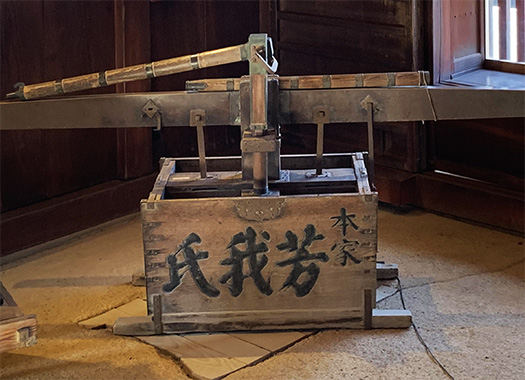


江戸期からこの上芳我家は愛媛県・内子で木蝋生産で栄えてきた。
白蝋の大量生産・技術革新がこの家系によって確立したからとされる。
栃木県に芳賀という地名があるが、そもそもはその地から精蝋の技術をもって
この地に移住してきたという家系伝承。
栃木の芳賀出身者がどういうことでハゼノキ・木蝋とつながるのか、
この辺は探ってみても判然としない。
そして芳賀出身者が「芳我」と字が変化したことも不分明。
まぁ、文字変換自体はケースが散見されることではあるけれど・・・。
以前、考古的発見の現地説明会など栃木には愛媛県以上に訪問経験があり
「ハガって、そういえば栃木にあるよなぁ」と直感は持ってはいた。
それでガイドの方に「栃木と関連あるのですか?」と聞いた次第。
芳賀と芳我さんのルーツ、そして木蝋の関連について
機会を見てフィードバックして栃木県で深掘りしてみたい。
ハゼノキは九州が本場で神戸からの輸出最初期には九州産と混同されたという。
気候風土的に栃木よりも九州西岸地域との類縁性の方が高いだろう。
この上芳我家は、本家から分かれた13の分家の内の最大の成功者。
この住宅の創建はその木蝋生産の最盛期・明治38年頃とされている。
土佐から松山に抜ける街道・宿場町ではあるが、
深い山間の町でこういう輸出産業が出現したことになる。
店舗機能としての玄関土間部分はそう広くはなく、
それよりも商談・応接的な空間が展開している。
ただ、基本的な建築構成としては「商家」の造作と言っていい。
訪問客は土間空間で番頭さん・手代といった人に応接されたに違いない。
土間は2方向に開口されていて、道路側と屋外天日干し中庭側につながる。
原材料の搬入、製品の搬出などの通路でチェック機能を果たしたか。
土間に置かれた「芳我」文字入りのものはどうも運搬具のように思える。
荷姿としてはそう大きくはないが、加工製造された木蝋製品は
コンパクトだけれど貴重品という商品特性だったのだろう。
内子は松山方面への街道筋宿場なので、陸路で今治か松山方面に運ばれ
そこから瀬戸内海海路で神戸の貿易拠点に運搬されたと想像できる。


このオモテ空間の奥には賓客を接遇したと思える座敷空間が広がっている。
床の間付きの主室からは中庭の眺めが見晴らせている。
家系の氏素性をあきらかにするかのように仏壇も置かれている。
商売としては信用第一、永くやってきているというアピールとも思える。
考えて見ると古民家をたくさん見て来ているけれど
商家の場合でも対面販売型の生業の家が多く、
この家のように工業生産・加工生産品型の製造業というケースはマレかも。
振り売りに近い店舗空間ではない、商工自営者という存在としての
あり方が建築の造作の随所に表れているのでしょうね。
あるいは同じ明治期の北海道の漁業生産施設「ニシン御殿」に近いのかも。
English version
[Old folk house / front space of manufacturing commerce and industry ④ Shikoku living space-42]
The storefront of the high-priced processed product manufacturing industry in the Meiji era, which is neither a farmer nor a merchant for sale. A reception space for visitors.・ ・ ・
Since the Edo period, this Kamihoga family has prospered in the production of Japan wax in Uchiko, Ehime Prefecture.
It is said that the mass production and technological innovation of white wax was established by this family.
There is a place named Haga in Tochigi prefecture, but in the first place, with the technology of refined wax from that place
A family tradition that has emigrated to this area.
How do people from Haga in Tochigi connect with Hazenoki and Japan wax?
This area is not clear even if you explore it.
And it is unclear that the character of the person from Haga changed to “Hoga”.
Well, the character conversion itself has some cases, but …
Previously, Tochigi has more experience of visiting than Ehime prefecture, such as local information sessions on archaeological discoveries.
I had an intuition that “Haga is in Tochigi.”
So I asked the guide, “Is it related to Tochigi?”
About the roots of Haga and Haga, and the relationship between Japan wax
I would like to take the opportunity to give feedback and dig deeper in Tochigi Prefecture.
Hazenoki is said to have been confused with Kyushu products at the earliest stage of export from Kobe, where Kyushu is the home.
In terms of climate, it is more likely to be related to the west coast of Kyushu than Tochigi.
The Kamihoga family is the most successful of the 13 branch families separated from the head family.
The construction of this house is said to be around 1883, the peak of the production of Japan wax.
Although it is a highway / post town that runs from Tosa to Matsuyama,
This kind of export industry has emerged in a deep mountain town.
The entrance area as a store function is not so large,
Rather than that, a space for business negotiations and reception is developing.
However, as a basic architectural composition, it can be said that it is a “merchant” structure.
The visitor must have been treated by a person such as a clerk or a clerk in the dirt floor space.
The dirt floor is open in two directions and connects to the road side and the outdoor sun-dried courtyard side.
Did you perform the check function in the aisles such as carrying in raw materials and carrying out products?
The one with the “Hoga” character placed in the dirt seems to be a carrier.
Although it is not so big as a package, the processed and manufactured Japan wax products are
Although it is compact, it must have been a valuable product.
Uchiko is a post station on the highway to Matsuyama, so you can take it by land to Imabari or Matsuyama.
From there, it can be imagined that it was transported by the Seto Inland Sea Route to a trading base in Kobe.
In the back of this front space, there is a tatami room that seems to have treated guests.
The main room with an alcove overlooks the courtyard.
A Buddhist altar is also placed as if to reveal the identity of the family.
As a business, credit is first, and it seems to be an appeal that it has been coming for a long time.
When I think about it, I’ve seen a lot of old folk houses
Even in the case of merchant houses, there are many face-to-face sales type livelihood houses,
The case of industrial production / processed production type manufacturing industry like this house may be male.
As a self-employed business and industry, not a store space close to a fururiuri
Perhaps the way it should be appears everywhere in the architectural structure.
Or maybe it is close to the fishing production facility “Nishin Goten” in Hokkaido during the same Meiji era.
Posted on 4月 6th, 2022 by 三木 奎吾
Filed under: 住宅マーケティング, 日本社会・文化研究








コメントを投稿
「※誹謗中傷や、悪意のある書き込み、営利目的などのコメントを防ぐために、投稿された全てのコメントは一時的に保留されますのでご了承ください。」
You must be logged in to post a comment.